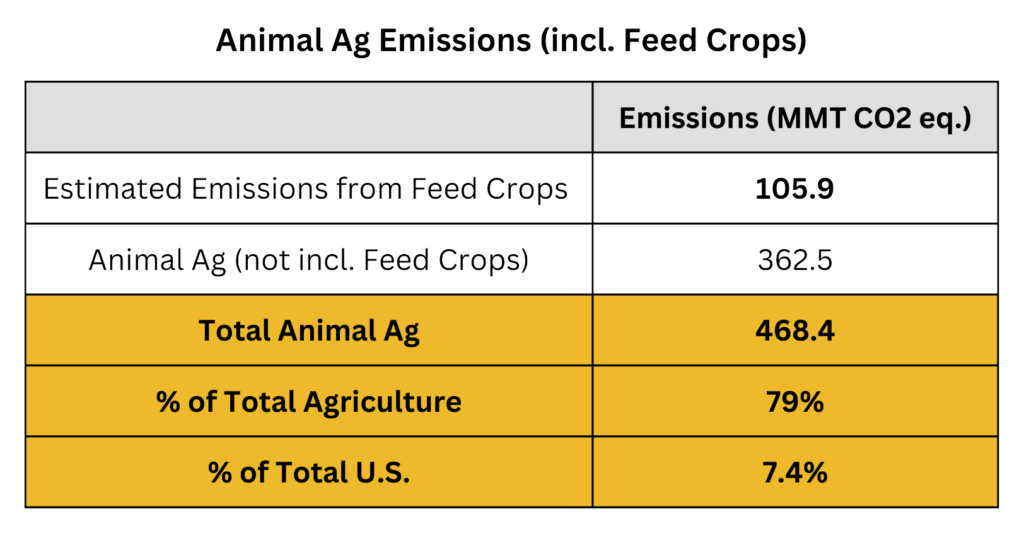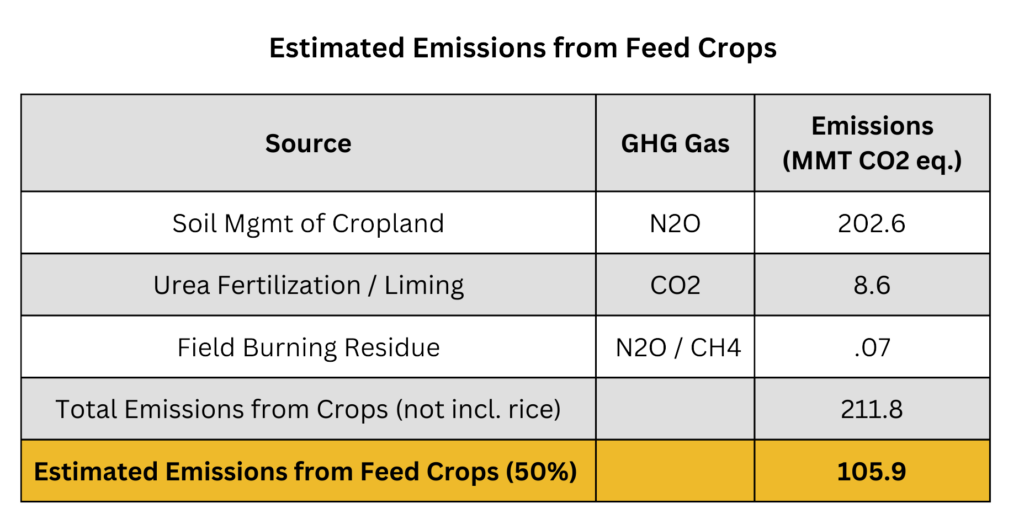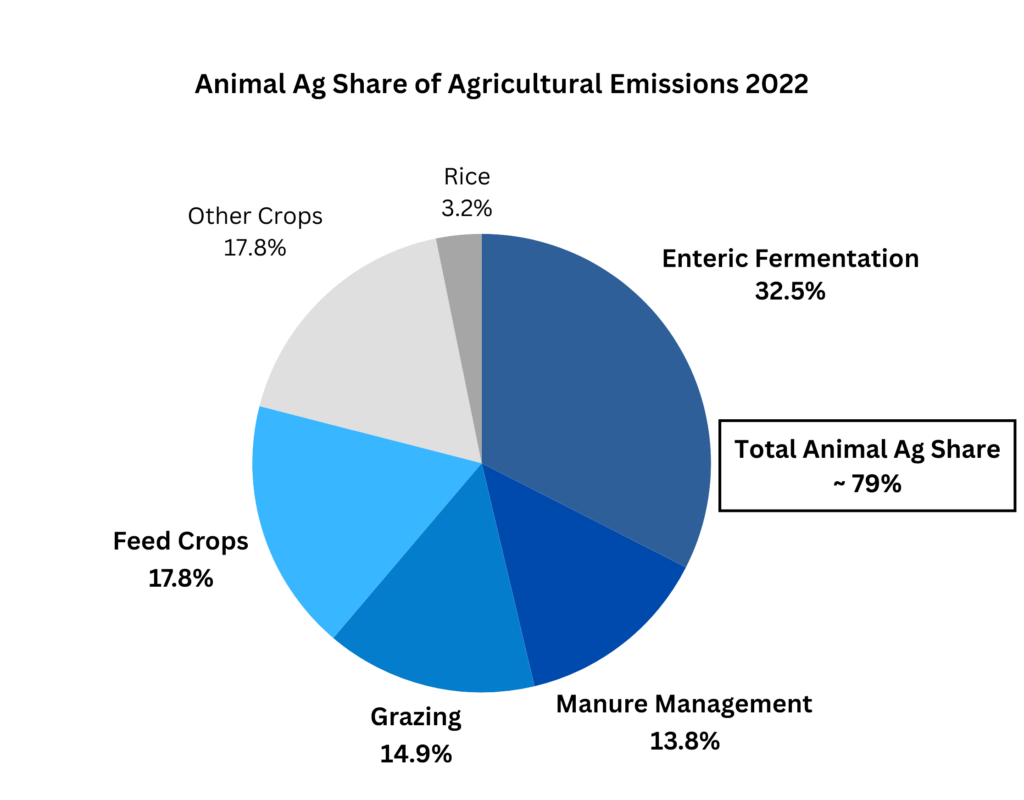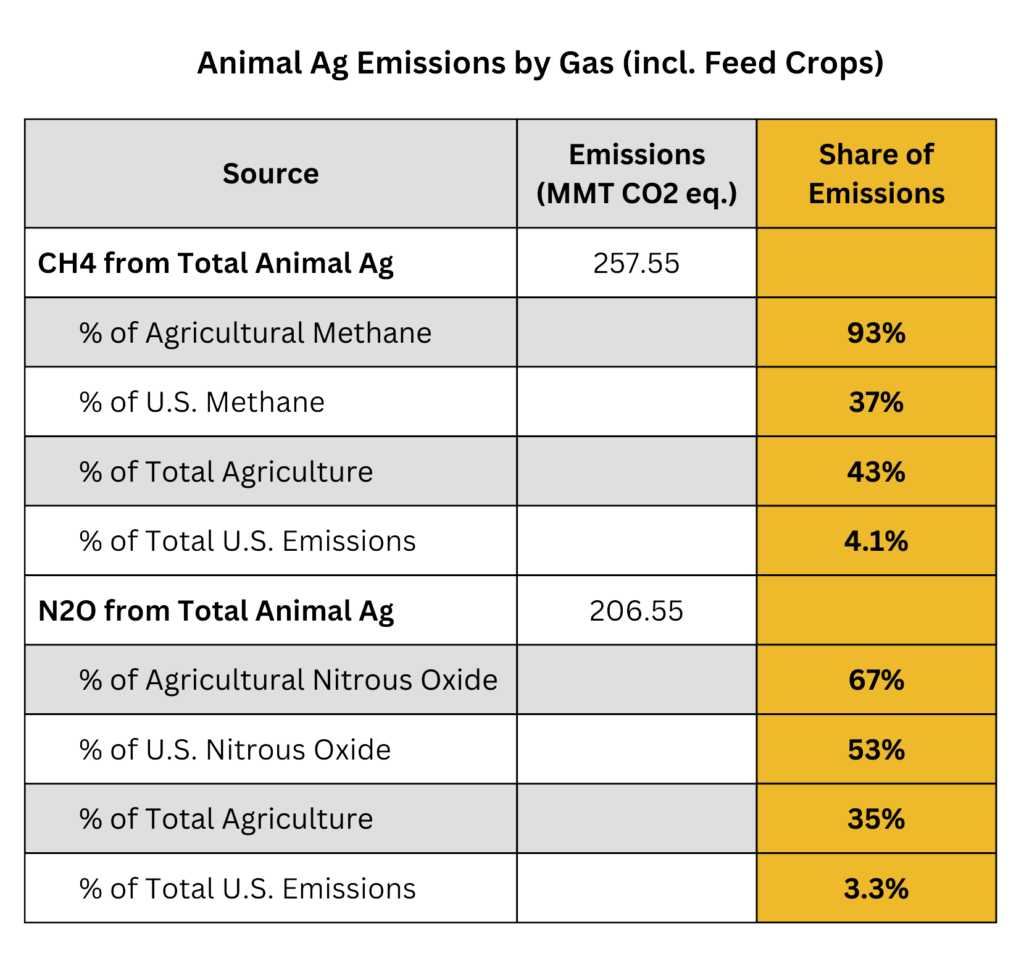The EPA calculates that in 2022, agriculture was responsible for 9.4% of total U.S. anthropogenic greenhouse gas emissions.[1,2]
EPA (2024) Inventory of U.S. Greenhouse Gas Emissions and Sinks: 1990-2022, EPA 430-D-24-004, Table ES-3. [Total agriculture of 593.4 MMT CO2 Eq (million metric tonnes) / total gross emissions of 6,343.2 MMT = 9.355%. The EPA calculation includes agricultural soil management, enteric fermentation in domestic livestock, livestock manure management, rice cultivation, urea fertilization, liming, and field burning of agricultural residues. According to the EPA, the choice of these categories and the methodologies used to calculate emissions within these categories follow international protocols as outlined by the IPCC in the “2006 IPCC Guidelines for National Greenhouse Gas Inventories” and are “presented in a common format in line with the reporting guidelines for the reporting of inventories under the Paris Agreement and the UNFCCC (United Nations Framework Convention on Climate Change).” See, Box 5-1, pp. 5-3 & 5-4]
EPA (2024) Inventory of U.S. Greenhouse Gas Emissions and Sinks: 1990-2022, Table ES-5 and fn 23, p. ES-20. [Adding agriculture’s on-farm share of emissions of fossil fuels and electricity use, the agriculture “economic sector” is responsible for ~10% of total emissions. Calculation: Agriculture 632.7 MMT CO2 Eq. / Total gross emissions 6,341.2 MMT CO2 Eq. = 9.98%]
Based on the EPA’s 2022 figures, ~61% of total agricultural emissions can be directly attributed to animal agriculture (not including feed crops).[1]
Animal ag’s share of emissions (not including feed crops) is nearly 6% of total U.S. GHG emissions.[2-4]

The EPA does not aggregate these categories under “animal agriculture,” nor does it make the calculation that 61% of emissions can be attributed to animal ag (not including feed crops) – that’s our calculation. We add N2O from “Soil Management of Grassland” to the calculation since we believe it is entirely or almost entirely attributable to grazing management practices (see, fn 3) As a point of comparison, an earlier 2022 USDA report estimates “emissions from livestock” at 56% of all agricultural emissions for 2018, including “grazed lands.” This figure includes some negative emissions from land use change. See, USDA Office of the Chief Economist (2022) Greenhouse Gas Inventory 1990-2018, Technical Bulletin No. 1957, Table 2-1.
EPA (2024) Inventory of U.S. Greenhouse Gas Emissions and Sinks: 1990-2022, EPA 430-D-24-004, Table 5-1. [Enteric Fermentation on pp. 5-4 to 5-5. Manure Management on pp. 5-11 to 5-14. Soil Management of Grasslands on pp. 5-28 to 5-35, including Tables 5-15, 5-16, and 5-17]
For confirmation that “grasslands” is essentially the same as “grazing land” (the EPA does not explicitly classify it as such) see, USDA (2022) U.S. Agriculture and Forestry Greenhouse Gas Inventory: 1990–2018, Table 2-1 and Figure 1-1. USDA considers “grasslands” as “grazed lands” and divides N2O emissions from soils into “grazed land” (p. 24) and “cropland agriculture” (p. 59). USDA attributes 15% of total agricultural GHG emissions to “grazed land” – similar to EPA’s “soil management of grasslands” which is 88.2 / 593.4 = 14.9%. See also, 2006 IPCC Guidelines for National Greenhouse Gas Inventories Vol. 4, Agriculture, Forestry and Other Land Use, on which the EPA relies for methodology. “Grasslands generally have vegetation dominated by perennial grasses, and grazing is the predominant land use,” p. 6.5.
Some analyses report (or imply) that animal ag emissions are ~4% of total U.S. emissions. They include neither grazed land nor feed crops. See for example, USDA paper claiming that 3.9% of U.S. emissions are from “livestock and their manure.” [Rotz, A., & Rotz, C. A. (2020). Environmental sustainability of livestock production. Meat and Muscle Biology, 4(2), p. 7.] This figure is based on protocols in EPA annual reports that do not explicitly attribute emissions from grazing land to livestock and do not examine the role of feed crops in total animal ag emissions.
Animal ag emissions, including emissions from feed crops, are broadly estimated at ~79% of total agricultural emissions.
About 7.4% of total U.S. GHG emissions can be attributed to animal agriculture, including emissions from feed crops.[1]

These figures include the share directly attributable to livestock plus an estimated 50% of the emissions from soil management of croplands. This is based on estimates that more than 50% of U.S. cropland is specifically allocated to animal feed.[2-4]

U.S. EPA (2024) Inventory of U.S. Greenhouse Gas Emissions and Sinks: 1990-2022, EPA 430-D-24-004. Here we add 50% of emissions from cropland practices to the totals attributed to animal ag, given our assessment that more than 50% of U.S. cropland is specifically allocated to animal feed. The EPA does not aggregate these categories under “animal agriculture,” nor does it attribute any portion of soil management to feed crops; those are our calculations. See Table 5-1 for total agricultural emissions = 593.4 MMT CO2 eq.; See Page ES-5 for total U.S. emissions = 6,343.2 MMT CO2 eq.
For portions of Soil Management attributed to Croplands, see EPA (2024) Inventory, Table 5-15. Total emissions from crops also include 50% of other minor emissions categories typically from croplands: Urea Fertilization, Liming, and Field Burning Residue. Rice is excluded from crop emission calculations because it is treated as a separate category by the EPA due to its high methane emissions.
Note: We are not aware of recent reports that allocate shares of agricultural GHG emissions by individual crops on a national basis. The wide variation in regional climates, tillage and irrigation practices, types of soils, fertilizer usage, etc., makes this a challenging research subject. There is evidence that emissions from corn (the primary feed crop) are particularly high due to the amount of nitrogen fertilizer application (~47% of total nitrogen in chemical fertilizers applied in the U.S.). Soybeans tend to have lower agricultural emissions because legumes fix nitrogen in the soil and do not require high levels of nitrogen application. However, the much lower yield of soybeans (relative to corn) increases the emissions per pound. A report focused on crop production in the Northeast estimated agricultural emissions for soybeans at ~60% of corn, while also noting that information about “emissions from agricultural crops is scattered throughout the literature, and estimates for the same crop species can be quite variable.” (See: Camargo, G. G., et al., (2013). Energy use and greenhouse gas emissions from crop production using the farm energy analysis tool. BioScience, 63(4), 263-273. Figure 1 and p. 263.)
Large portions of corn and soybeans used for animal feed go through extensive processing after the farm gate. Although this processing is outside the normal parameters of agricultural emissions, the energy usage and product transports tend to make feed crops a larger GHG footprint in general. Corn and soybean emissions have been assessed at comparable levels based on a lifecycle analysis, with corn and soybean feed by-products at higher levels, and alfalfa, other hay, and silage generally lower. (See: Adom, F., et al., (2012). Regional carbon footprint analysis of dairy feeds for milk production in the USA. The International Journal of Life Cycle Assessment, 17, 520-534. Table 6)
For estimates of cropland used for animal feed, see Total Feed Crops Share
They are higher on a per capita basis. They are only low as a portion of the outsized per capita GHG contributions of the U.S., which are ~2.6 times the global average.[1]
U.S. animal ag emissions would be ~20% of total U.S. emissions if, in other sectors, the U.S were an average GHG emitter.[2] At 20%, U.S. animal ag emissions would be higher than the commonly quoted figure attributing 14.5% of global GHG emissions to animal agriculture.[3]
Comparatively, U.S. per capita animal ag emissions equal ~47% of the total per capita emissions of India.[4]
Some portion of these high per-capita animal ag emissions can be attributed to exports of animal products and feed crops. However, U.S. agriculture’s focus on animal products and relatively low-value feed crops has contributed to the U.S. becoming a net importer of food.[5] This despite the USDA’s high levels of support for exports and their vision of an agricultural system that “feeds the world.”[6]
Crippa, M., et al., (2023). GHG emissions of all world countries, Publications Office of the European Union, Luxembourg, 2023, doi:10.2760/953332, JRC134504, p. 242.
Calculation: Animal Ag contributions of 7.38% of Total U.S. * 2.65 per capita multiplier = 19.6%.
Gerber, P. J., et al., (2013). Tackling climate change through livestock: a global assessment of emissions and mitigation opportunities. Food and agriculture Organization of the United Nations (FAO). [Note that this report includes additional categories not counted in the EPA report – including land-use change and the transportation and processing of animal products.]
Crippa, M. et. al., (2023), p. 133 (India) and p. 242 (US). [Calculation: U.S per capita emissions = 17.90 tonnes CO2 eq. and India = 2.79 tonnes. 17.9 * .074 = 1.32/ 2.79 = 47.3%.
USDA (2024) U.S. agricultural import values outpaced export values in fiscal year 2023. https://www.ers.usda.gov/data-products/chart-gallery/gallery/chart-detail/?chartId=58310
USDA (2022) Strategic Plan Fiscal Years 2022-2026, p. 3
Broadly estimated, ~79% of agriculture’s total GHG emissions can be attributed to animal agriculture (including feed crops).[1,2] Enteric fermentation, at about one-third of agricultural emissions, is the largest category.
Category emissions for enteric fermentation, manure management, and rice by MMT Co2 eq. from EPA (2024) Inventory of U.S. Greenhouse Gas Emissions and Sinks: 1990-2022, EPA 430-D-24-004, Table 5-1. Category emissions for enteric fermentation on pp. 5-4 to 5-5. Manure Management on pp. 5-11 to 5-14. Soil Management of Grasslands on pp. 5-28 to 5-35, including Tables 5-15, 5-16, and 5-17. [Total animal ag calculations are partially based on an estimate that feed crops are responsible for ~50% of cropland emissions.]
For confirmation that “grasslands” is essentially the same as “grazing land” (the EPA does not explicitly classify it as such) see, USDA (2022) U.S. Agriculture and Forestry Greenhouse Gas Inventory: 1990–2018, Table 2-1 and Figure 1-1. USDA considers “grasslands” as “grazed lands” and divides N2O emissions from soils into “grazed land” (p. 24) and “cropland agriculture” (p. 59). USDA attributes 15% of total agricultural GHG emissions to “grazed land” – similar to EPA’s “soil management of grasslands” which is 88.2 / 593.4 = 14.9%. Also see, 2006 IPCC Guidelines for National Greenhouse Gas Inventories Vol. 4, Agriculture, Forestry and Other Land Use, on which the EPA relies for methodology. [“Grasslands generally have vegetation dominated by perennial grasses, and grazing is the predominant land use,” p. 6.5.]

Note that CO2 emissions from U.S. agriculture are small, totaling 8.6 MMT CO2 eq / 593.4 = 1.4% of total agricultural emissions and 8.6 / 6,343.2 = .14% of total U.S. emissions. Total animal ag calculations are partially based on an estimate that feed crops are responsible for about 50% of cropland emissions.]
Most likely, yes, though we have limited info on national emissions by specific crops. Corn, primarily used for feed and the largest U.S. crop, uses almost half the total chemical nitrogen fertilizer applied in the U.S. (~47%).[1] Nitrogen in chemical fertilizers is likely the primary source of N2O emissions.[2]
Soybeans, the 2nd largest crop, also used primarily for feed, fixes nitrogen in the soil as do most legumes. Broadly estimated, the total nitrogen fixation of soybeans, alfalfa/hay, and cultivated pasture equals ~70% of the nitrogen in total chemical fertilizer applications.[3,4]
Excess nitrogen generated during crop production is the primary source of GHG emissions from cropland soil management. Soil management generates the largest quantity of nitrous oxide (N2O) emissions and is the largest category of emissions from agriculture. The largest sources of excess nitrogen are chemical fertilizers, manure applications, and the fixing of nitrogen in legume production.[5,6]
The USDA estimates the share of N2O emissions by specific crop management systems. In order, the largest share of emissions is from row crops (∼47%) of which corn and soybeans are the two largest.[7] The next highest share comes from irrigated crops (∼11%), of which the majority are corn, soybeans, and alfalfa/hay.[8] Emissions from hay production and pasture are ~8%.[9]
Both the EPA and USDA confirm that N2O emissions are highest in the Midwestern Corn Belt where a large portion of the land is used for growing corn and soybeans.[10,11]
GHG emissions from feed crops should be added to the long list of negative externalities of animal ag.
See, Chemical Fertilizer Use on Feed Crops
Shcherbak, I., et al., (2014). Global metaanalysis of the nonlinear response of soil nitrous oxide (N2O) emissions to fertilizer nitrogen. PNAS, 111(25), 9199-9204. [“Nitrogen (N) fertilizer rate is the best single predictor of N2O emissions from agricultural soils…”]
Sobota, D. J., et al., (2013). Reactive nitrogen inputs to US lands and waterways: how certain are we about sources and fluxes? Frontiers in Ecology and the Environment, 11(2), 82-90, Table 2. [7.7 Tg N / 10.9 Tg N = 71%.]
U.S. EPA (2011) Reactive Nitrogen in the United States: An Analysis of Inputs, Flows, Consequences, and Management Options, A Report of the EPA Science Advisory Board, Table 1.
EPA (2024) Inventory of U.S. Greenhouse Gas Emissions and Sinks: 1990-2022, EPA 430-D-24-004, pp. 5-2 to 5-3. [“Emissions of N2O by agricultural soil management through activities such as fertilizer application and other agricultural practices that increased nitrogen availability in the soil was the largest source of U.S. N2O emissions…”]
USDA Office of the Chief Economist (2022) Greenhouse Gas Inventory 1990-2018, Technical Bulletin No. 1957, p. 59. [“Nitrous oxide emissions from soils are the largest anthropogenic source in the United States because of nitrogen management practices. Large amounts of nitrogen are added to crops from fertilizer amendments and legume cropping, which stimulate N2O production.” at p. 59]
USDA (2022) Greenhouse Gas Inventory 1990-2018, p. 64 [“Emissions are highest from row crops (mostly corn and soybean) because row crops cover the largest land area (Map 3-2) and nitrogen inputs are often high from fertilization in rows crops, such as corn, and due to biological fixation in legumes that are grown as row crops, such as soybeans.”]
See, Water Usage for Feed Crops
USDA (2022) Greenhouse Gas Inventory 1990-2018, Table 3-4.
EPA (2024) Inventory of U.S. Greenhouse Gas Emissions and Sinks, p. 5-31. [“Direct N2O emissions from croplands occur throughout all of the cropland regions but tend to be high in the Midwestern Corn Belt Region (particularly, Illinois, Iowa, Kansas, Minnesota, Nebraska), where a large portion of the land is used for growing highly fertilized corn and nitrogen-fixing soybean crops.”] [“Indirect N2O emissions from surface runoff and leaching of applied/mineralized nitrogen in croplands is highest in the Midwestern Corn Belt.” at p. 5-33]
USDA (2022) Greenhouse Gas Inventory 1990-2018, p. 64. [“Emissions are highest from row crops (mostly corn and soybean) because row crops cover the largest land area (Map 3-2) and nitrogen inputs are often high from fertilization in rows crops, such as corn, and due to biological fixation in legumes that are grown as row crops, such as soybeans.”]
Definitions of agricultural emissions can vary. The EPA’s tally of 9.4% of U.S. emissions includes most on-farm activities.[1] It does not include:
On-farm electric and fuel usage: Adding these factors brings ag emissions to 10% of total U.S. emissions.[2]
Chemical fertilizer production: Producing fertilizers, especially ammonia and nitric acid for nitrogen fertilizers, is highly energy intensive.[3,4]
Land use: Land areas can act as a sink (absorbing CO2 from the atmosphere) or a source of GHG emissions. In general, conversion from more natural areas (like forests or natural grasslands) to more actively managed areas (like cropland or grazing land) increases emissions. Converting back to more natural ecosystems can reduce emissions.[5]
Many other factors can be included in broader “lifecycle” or “food system” analyses, including transportation of animals and feed, food processing, retail, and food waste.[6]
Finally, there is some evidence that current evaluation models consistently underestimate emissions from animal ag.[7,8] This may be due to the decentralized nature of the industry and the challenges of monitoring non-point sources.[9] It also may reflect a cultural bias that tends to protect agricultural interests from environmental constraints.[10]
EPA (2024) Inventory of U.S. Greenhouse Gas Emissions and Sinks: 1990-2022, EPA 430-D-24-004, p. ES-18 [Total agriculture includes “agricultural soil management, enteric fermentation in domestic livestock, livestock manure management, rice cultivation, urea fertilization, liming, and field burning of agricultural residues.”]
EPA (2024) Inventory of U.S. Greenhouse Gas Emissions and Sinks: 1990-2022, Table ES-5 and fn 23 p. ES-20. [Adding agriculture’s on-farm share of emissions of fossil fuels and electricity use, the agriculture “economic sector” is responsible for about 10% of total emissions. Calculation: Agriculture 632.7 MMT CO2 Eq. / Total gross emissions 6,341.2 MMT CO2 Eq. = .99%]
EPA (2024) Inventory of U.S. Greenhouse Gas Emissions and Sinks: 1990-2022, pp. 4-32 to 4-33, Table 4-23 [ammonia]; pp. 4-41 to 4-42, Table 4-31 [nitric acid].
Daramola, D. A., & Hatzell, M. C. (2023). Energy demand of nitrogen and phosphorus based fertilizers and approaches to circularity. ACS Energy Letters, 8(3), 1493-1501. [“Ammonia synthesis is widely recognized as an energy intensive process and is currently the fourth largest energy consumer in the chemical manufacturing sector in the United States.” at p. 1493]
Hayek, M. N., et al., (2021). The carbon opportunity cost of animal-sourced food production on land. Nature Sustainability, 4(1), 21-24, p. 21. [Calculates the global potential for carbon sequestration from converting land currently used for animal ag production back to more natural ecosystems. “The cumulative potential of CO2 removal on land currently occupied by animal agriculture is comparable in order of magnitude to the past decade of global fossil fuel emissions.”]
For an analysis of total emissions from the global food system see, Crippa, M., et al., (2021). Food systems are responsible for a third of global anthropogenic GHG emissions. Nature Food, 2(3), 198-209, p. 198. [Including retail, transport, consumption, fuel production, waste management, industrial processes and packaging]
Hayek, M. N., & Miller, S. M. (2021). Underestimates of methane from intensively raised animals could undermine goals of sustainable development. Environmental Research Letters, 16(6), 063006.
Lawrence, N. C., et al., (2021). Nitrous oxide emissions from agricultural soils challenge climate sustainability in the US Corn Belt. PNAS, 118(46), e2112108118.
Pretty, J. et al., (2001) Policy Challenges and Priorities for Internalizing the Externalities of Modern Agriculture, Journal of Environmental Planning and Management, 44(2), 263-283, p. 265. [“The types of externalities encountered in the agricultural sector have four features: (1) their costs are often neglected; (2) they often occur with a time lag; (3) they often damage groups whose interests are not represented; and (4) the identity of the producer of the externality is not always known.”]
Ruhl, J.B. (2000) Farms, Their Environmental Harms, and Environmental Law. Ecology Law Quarterly, 27(2), 263, p. 269. [“One would be hard pressed to identify another industry with as poor an environmental record and as light a regulatory burden.”]
